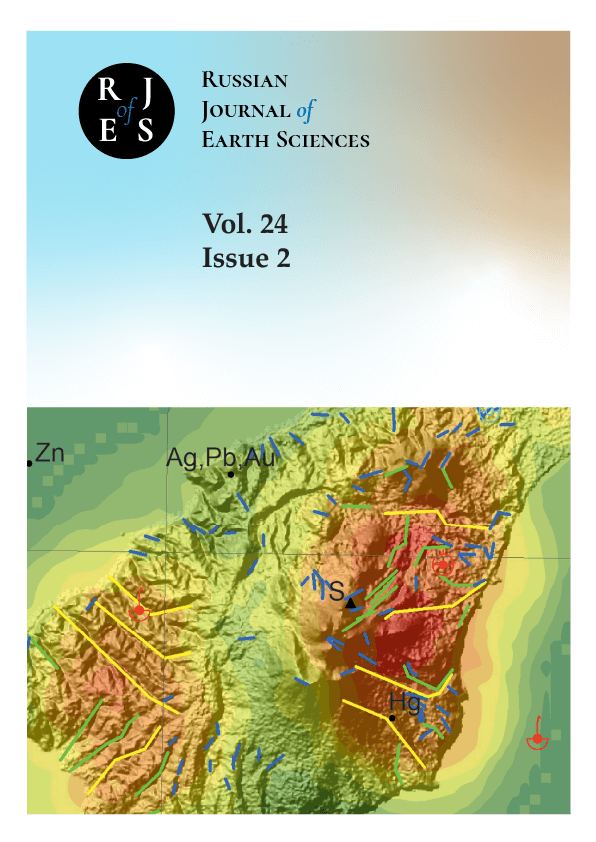Moskva, Russian Federation
Institute of Earthquake Prediction Theory and Mathematical Geophysics of the Russian Academy of Sciences
Schmidt Institute of the Physics of the Earth Russian Academy of Sciencies
Geophysical Center of the Russian Academy of Sciences
Moscow, Moscow, Russian Federation
Russian Federation
Fedorov Institute of Applied Geophysics
Russian Federation
UDC 55
CSCSTI 37.00
CSCSTI 38.00
Russian Classification of Professions by Education 05.00.00
Russian Library and Bibliographic Classification 26
Russian Trade and Bibliographic Classification 63
BISAC SCI SCIENCE
An algorithm for identifying seismic generation zones or “seismic domains” using fuzzy logic has been developed and tested on the island of Sakhalin. Initial data were obtained from diagrams of the distribution of “weak” zones, relief elevation distribution skewness, and magnitude of recent area deformation for one year. These data were processed using a γ-operator in fuzzy logic with γ = 0.9, which allowed us to identify areas with high seismic activity. The areas where these active areas intersect with zones with increased compressive stress values, as determined by computer modeling, were considered to be seismic zones. It was shown that, if there are not enough source materials available, it is possible to exclude information about the recent deformation field from consideration and use an assumed grid of active faults for computer modeling. This approach may be useful when analyzing areas that have not been studied well.
morphometric analysis of relief, fuzzy logic, neotectonics, seismotectonics, seismodomains, seismic generation zone, GNSS
1. Belyaev, A. M., A. E. Mikhnin, and M. V. Rogachev (2023), ROC analysis and logical regression in MedCalc, 36 pp., National Medical Research Center of Oncology named after N. N. Petrova (in Russian).
2. Delone, B. N. (1934), On the emptiness of the sphere, Izvestiya Akademii Nauk SSSR, (4), 793–800 (in Russian).
3. Dzeboev, B. A., A. D. Gvishiani, I. O. Belov, V. N. Tatarinov, S. M. Agayan, and Yu. V. Barykina (2019), Strong-EarthquakeProne Areas Recognition Based on an Algorithm with a Single Pure Training Class: I. Altai-Sayan-Baikal Region, M ≥ 6.0, Physics of the Earth, (4), 33–47, https://doi.org/10.31857/S0002-33372019433-47 (in Russian).
4. Gridchina, M. S., G. M. Steblov, I. S. Vladimirova, and A. V. Basmanov (2023), Investigation of the Lithospheric Plate Boundary Zone within Sakhalin Island Based on Satellite Geodesy Data, Geophysical Research, 24(4), 81–96, https://doi.org/10.21455/gr2023.4-5 (in Russian).
5. Gvishiani, A. D., B. A. Dzeboev, S. M. Agayan, I. O. Belov, and J. I. Nikolova (2021), Fuzzy Sets of High Seismicity Intersections of Morphostructural Lineaments in the Caucasus and in the Altai-Sayan-Baikal Region, Journal of Volcanology and Seismology, 15(2), 73–79, https://doi.org/10.1134/s0742046321020032. EDN: https://elibrary.ru/NPTTHH
6. Kostenko, N. P. (1999), Geomorphology, 379 pp., Moscow University, Moscow (in Russian).
7. Kulchinsky, R. G., E. P. Kharin, I. P. Shestopalov, A. D. Gvishiani, S. M. Agayan, and S. R. Bogoutdinov (2010), Fuzzy logic methods for geomagnetic events detections and analysis, Russian Journal of Earth Sciences, 11, RE4003, https://doi.org/10.2205/2009ES000371 (in Russian). EDN: https://elibrary.ru/UEIFCP
8. Lehner, B., and G. Grill (2013), Global river hydrography and network routing: baseline data and new approaches to study the world’s large river systems, Hydrological Processes, 27(15), 2171–2186, https://doi.org/10.1002/hyp.9740. EDN: https://elibrary.ru/RRKVLX
9. Nechaev, Yu. V. (2010), Lineaments and tectonic fragmentation: remote sensing of the internal structure of the lithosphere, 215 pp., IPE RAS, Moscow (in Russian).
10. Oskorbin, L. S. (1997), Seismogenic zones of Sakhalin and adjacent regions, Problems of seismic hazard of the Far Eastern region, pp. 157–178 (in Russian).
11. RB-019-18 (2018), Safety Guide to the Use of Atomic Energy “Assessment of the Initial Seismicity of the Area and Site of a Nuclear Energy Use Object During Engineering Surveys and Research” (in Russian).
12. Rebetsky, Yu. L., L. A. Sim, and A. V. Marinin (2017), From slip surfaces to tectonic stresses. Methods and algorithms, 234 pp., GEOS, Moscow (in Russian).
13. Steblov, G. M., A. O. Agibalov, V. M. Makeev, V. P. Perederin, F. V. Perederin, and A. A. Sentsov (2023), On the problem of estimation of the maximum possible earthquake magnitudes on Sakhalin island by various methods, Problems of Engineering Seismology, 50(4), 25–35, https://doi.org/10.21455/vis2023.4-2 (in Russian). EDN: https://elibrary.ru/BTCRLN
14. Ulomov, V. I. (1987), Lattice model of focal seismicity and forecast of seismic hazard, Uzbekistan Geological Journal, (6), 20–25 (in Russian).
15. United States Geological Survey (2023), Search Data Catalog, https://lpdaac.usgs.gov/product_search/?collections=MEaSUREs+SRTM&status=Operational&view=list, (date of access: 01.01.2023).
16. Zelenin, E., D. Bachmanov, S. Garipova, V. Trifonov, and A. Kozhurin (2022), The Active Faults of Eurasia Database (AFEAD): the ontology and design behind the continental-scale dataset, Earth System Science Data, 14(10), 4489–4503, https://doi.org/10.5194/essd-14-4489-2022. EDN: https://elibrary.ru/JDRWYB
17. Zimmermann, H.-J. (2001), Fuzzy Set Theory - and Its Applications, 435 pp., Springer Netherlands, https://doi.org/10.1007/978-94-010-0646-0.


















